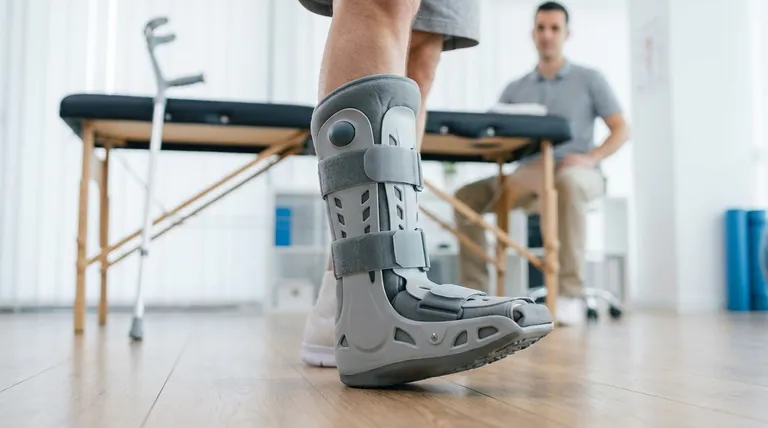In short, a walking boot aids recovery by providing a critical balance between protection and mobility. It uses a rigid shell to immobilize the injured area, preventing harmful movements, while its specialized design redistributes your body weight away from the injury and helps you maintain a more natural walking motion.
A walking boot is not just a modern cast; it is an engineered tool designed to control motion, reduce pressure on a specific injury site, and allow for safe, early weight-bearing, which can significantly accelerate the healing process.

The Core Mechanics: How a Boot Protects and Promotes Healing
To understand why a walking boot is so effective, you need to look at its specific design features. Each element serves a distinct purpose in protecting the injured tissue while encouraging a safe return to function.
Immobilization: The Foundation of Recovery
The most fundamental job of the boot is to immobilize the injured foot or ankle. Its rigid plastic shell and adjustable straps create a secure structure that prevents the bones, tendons, and ligaments from moving in ways that could cause re-injury or disrupt the healing process.
Weight Redistribution: Taking the Load Off
When you walk, your body weight creates significant force on your foot. The boot is designed to take this pressure off the injured area and redistribute it evenly across the entire foot and up into the lower leg. This offloading is crucial for reducing pain and allowing damaged tissues to mend without stress.
The Rocker Bottom: Enabling a More Natural Gait
A key feature of most walking boots is the rocker bottom sole. This curved design allows your foot to "roll" forward from heel to toe, mimicking a more natural walking pattern. This minimizes the need to bend your foot or ankle, which is often the primary source of pain and potential re-injury.
Adjustability for Comfort and Swelling
Unlike a hard cast, a walking boot can be easily adjusted. The straps allow you to secure it for stability while accommodating the inevitable swelling that occurs after an injury or surgery. Some models even include an adjustable heel lift to place the ankle in the least painful position.
Understanding the Trade-offs and Common Pitfalls
While highly effective, a walking boot is a medical intervention with inherent trade-offs. Being aware of these helps ensure your recovery stays on track.
Muscle Atrophy is a Reality
Immobilizing a limb will inevitably lead to some degree of muscle weakness (atrophy) in your calf and foot. This is a normal part of the process and is why physical therapy is often required after you stop using the boot.
Potential for Gait Imbalance
Wearing a single, taller boot can create a slight leg length discrepancy. Over time, this can lead to discomfort or strain in your hips and lower back. It is crucial to be mindful of your posture and follow professional guidance.
Over-reliance Can Delay Progress
The boot is a temporary tool, not a permanent solution. The ultimate goal is to transition out of it. Relying on it for too long can hinder the process of regaining your own strength, balance, and flexibility. Always follow the phased approach recommended by your healthcare provider.
How to Apply This to Your Recovery
Using a walking boot is a phase in a larger recovery plan. It is not a passive process; it requires active participation and professional oversight to be truly effective. A podiatrist or orthopedic specialist is essential for assessing the injury and ensuring the boot is the appropriate treatment.
- If your primary focus is healing a fracture or severe sprain: Trust the boot's ability to provide rigid protection and allow for safe weight-bearing as directed by your doctor.
- If your primary focus is post-surgical recovery: Utilize the boot's adjustability to manage swelling and its rocker sole to begin gentle movement without stressing the surgical site.
- If your primary focus is transitioning back to normal activity: Adhere strictly to your physical therapy plan to rebuild strength, improve flexibility, and normalize your walking pattern once the boot is removed.
Ultimately, the walking boot is a critical tool that bridges the gap between total rest and a full return to function.
Summary Table:
| Function | Key Benefit |
|---|---|
| Immobilization | Prevents harmful movement to protect healing tissues. |
| Weight Redistribution | Offloads pressure from the injury site to reduce pain. |
| Rocker Bottom Sole | Enables a natural walking gait without bending the ankle. |
| Adjustable Straps | Accommodates swelling and ensures a secure, comfortable fit. |
Ready to Source High-Quality Walking Boots?
As a large-scale manufacturer, 3515 produces a comprehensive range of medical and protective footwear for distributors, brand owners, and bulk clients. Our production capabilities ensure reliable, comfortable, and effective walking boots designed to support patient recovery.
Contact us today to discuss your specific needs and benefit from our expertise in medical footwear manufacturing.
Visual Guide

Related Products
- Safety Footwear Wholesale Manufacturer for Custom OEM/ODM Production
- Premium Grain Leather Safety Boots for Bulk Supply
- Customizable Anti-Smash Safety Boots for Wholesale & Private Label Manufacturing
- Custom Wholesale Leather Safety Boots Direct Factory Manufacturing
- Wholesale Safety Footwear Manufacturer for Bulk & Custom OEM Orders
People Also Ask
- What are the differences between steel toe, composite toe, and alloy toe Wellington boots? Choose the Right Safety Toe for Your Job
- Is safety-toe as good as steel toe? Choose the Right Protection for Your Job
- What are the cultural perspectives on wearing shoes in the house? A Guide to Home Etiquette & Hygiene
- What cultural and environmental considerations are tied to wearing shoes indoors? Balance Hygiene, Tradition, and Foot Health
- What do heavy duty boots do? Protect Your Feet in Demanding Work Environments



















